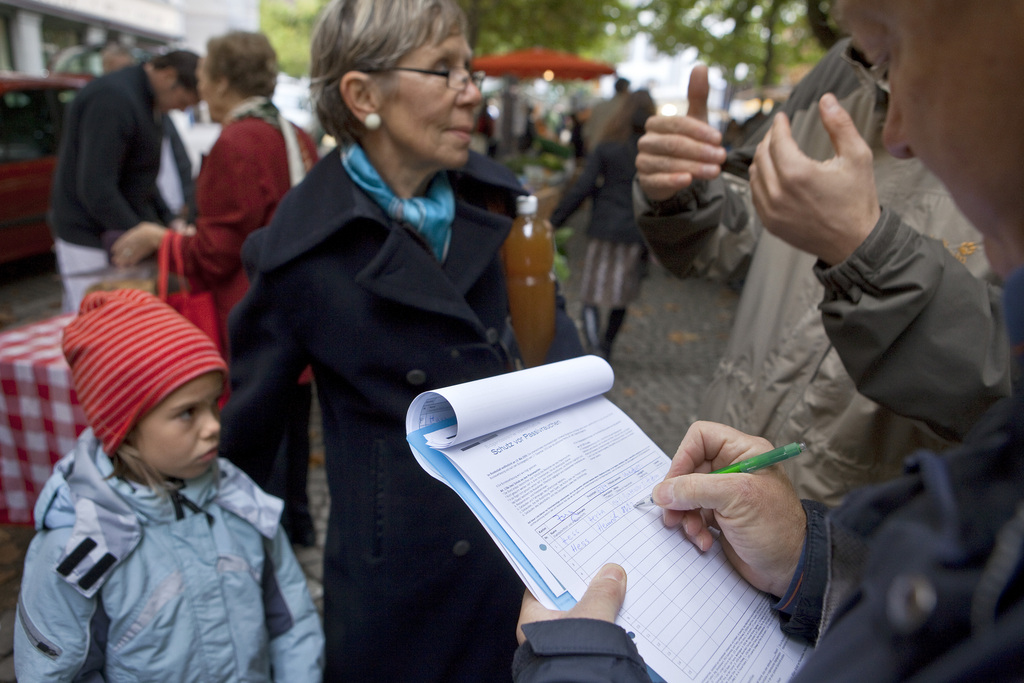Raising the bar for people’s initiatives

The number of people’s initiatives in Switzerland has been increasing steadily in recent years. Now a debate has started about making it harder to put them to a vote. The idea of raising the number of signatures required is receiving some support.
It’s Saturday afternoon on the Bärenplatz in Bern. Activists seeking signatures for people’s initiatives of all sorts make a point of setting up their tables on this crowded square in the Swiss capital, just a stone’s throw from the federal parliament.
Andy Tschümperlin knows the scene well. He has often been one of the signature hunters himself. “That’s how I first got politically involved – with an initiative in my local community,” says the parliamentarian and member of the centre-left Social Democratic Party. “Gathering signatures is part of my political job.”
The people’s initiative is one of the pillars of direct democracy in Switzerland. It allows citizens to bypass parliament and trigger a national vote on a topic that concerns them. But first they have to convince plenty of other people – in fact, gather 100,000 valid signatures within 18 months.
In spite of costs of up to CHF200,000 ($225,000) per people’s initiative, hardly a single interest group seems to be deterred. Recently, the number of people’s initiatives has increased just about every year.
“For the first 250 people’s initiatives it took about 100 years [after its introduction in 1848]. Now we are past the 400 mark,” points out Bruno Hofer, who has written a book on the subject. “The initiative has become part and parcel of political strategies.”
In his book Hofer writes that it “has become customary for all parties, even those represented in government, to distribute signature forms at regular intervals to the party faithful, so they can celebrate living, breathing democracy”.
The liberal thinktank Avenir Suisse is of the view that when it comes to these votes a less-is-more approach would be preferable to the current situation.
The reason for the ever-increasing number of initiatives, it suggests, is the fact that the population has increased, making it easier to gather the number of signatures required. The thinktank’s researchers reckon that “a doubling or even tripling of the necessary quota could be the remedy.”
Three proposals
These ideas have garnered the support of former State Secretary Jean-Daniel Gerber. In an interview with the Neue Zürcher Zeitung newspaper he suggested three options to reduce the number of people’s initiatives.
First, an increase in the required number of signatures from 100,000 to 200,000, since the population has notably increased since the last time the bar was raised in 1977.

Second, halving the time allowed for signature-gathering from 18 to nine months. Third, a quorum in parliament – only initiatives that earn the support of a certain percentage of parliamentarians would be put to a vote.
A quorum is unlikely to gain any traction among politicians and observers. “It perverts the basic character of the people’s initiative”, objects Hofer. “The whole point is being able to bypass parliament and go directly to the people.”
Martin Landolt, president of the centre-right Conservative Democratic Party, also thinks that this would “not necessarily foster grassroots democracy”.
He believes it is “only right that the people in Switzerland can be consulted without too many barriers”. On the other hand he is concerned “that this popular right could be abused”. On the whole issue he admits he “feels torn”.
Landolt also considers shortening the period allowed to gather signatures as a poor solution, because this could be overcome by marketing. And Hofer points out that the likelihood of an issue making it to a vote is pretty slim if most of the required signatures are not collected in the first three months anyway.
Automatic adjustment
Increasing the number of signatures is considered more favourably. Hofer would be in favour of an automatic mechanism of the kind introduced this year in Geneva, whereby 4% of eligible voters have to sign an initiative before it can be put to a vote.
Hofer reckons around 2.5% for nationwide votes would be fair, around 129,000 signatures at the moment. The current requirement, he points out, scarcely amounts to 2% of the 5.2 million Swiss voters.
Landolt finds this approach has its merits. It would be a way of keeping in step with future population trends. The option of increasing the number of signatures required is currently being discussed within his party, he adds.
Tschümperlin, on the other hand, is against increasing the number of signatures, “because even government parties can’t always gather the required signatures in time”.
Landolt admits that with an increase in the number of signatures there is the risk of doing more harm than good. “Precisely those groups who in my view misuse initiatives and referenda as a marketing instrument will probably have the resources to keep on doing it even if the requirement for signatures is higher”, he adds.
This is the problem that is driving the internal discussion in his party right now, he says. “On the one hand we see the need to act, on the other we are not convinced that the result will be the one we want,” he points out.
As the NZZ am Sonntag reported on December 15, Landolt and 39 other parliamentarians recently submitted a motion to the cabinet aiming to examine “limiting mechanisms for people’s initiatives” and thereby also highlight creative approaches. Thus was born the idea that initiative signatures only be handed in to commune chancelleries, in order to make collection more difficult.
Response to problems?
For political scientist Marc Bühlmann, who researches direct democracy at the University of Bern and publishes a Swiss political yearbook, setting the bar higher is no solution.
In a recent study he looked into what happens at the cantonal level, where initiatives can also be submitted. The cantons vary quite a bit in the number of signatures they require, anywhere between 0.8 and 5% of the eligible voters.
“This variation does not, however, explain the people’s initiatives that actually take place”, he points out. “We have cantons that set the bar high, yet vote on a lot of initiatives, and cantons that set the bar low, but have few initiatives. There’s no clear connection.”
Tschümperlin agrees, citing what happens in his own commune “In my community, with its 14,000 inhabitants, individual citizens have the right to propose an initiative, and yet few such individual initiatives come before the voters,” he says.
Hofer emphasizes that the number of people’s initiatives submitted depends “not only on the conditions imposed on the use of the instrument. There are regions in Switzerland where there are a lot of problems pressing for solutions. This is expressed in people’s initiatives.”
The people’s initiative allows citizens to propose a change to the federal constitution. For the change to be put to a nationwide vote, 100,000 valid signatures have to be submitted to the federal chancellery within 18 months.
In the next stage, the proposal goes before parliament, which can accept the initiative, reject it, or make a counter-proposal. The people get to vote on it in any case.
For an initiative to succeed, it has to carry both a majority of voters and a majority of the cantons.
The cost of getting a people’s initiative submitted, according to the government website “ch.ch”, is at least CHF150,000.
There has been no study so far of the costs to the country as a whole of a people’s initiative and the associated parliamentary work.
A rough estimate from the federal chancellery says it costs the public purse CHF7 million to CHF8 million to organise and hold a nationwide vote. There are about four of these votes every year, and each time one or more initiatives are decided on.
On the other hand, costs for parliamentary preparatory work (study of the people’s initiative, working out a response, committee meetings and parliamentary debate) are fairly modest: they are estimated at about CHF200,000 per initiative. Of course the costs can go up steeply if a direct or indirect counter-proposal has to be drafted.
(Translated from German by Terence MacNamee)

In compliance with the JTI standards
More: SWI swissinfo.ch certified by the Journalism Trust Initiative








You can find an overview of ongoing debates with our journalists here . Please join us!
If you want to start a conversation about a topic raised in this article or want to report factual errors, email us at english@swissinfo.ch.